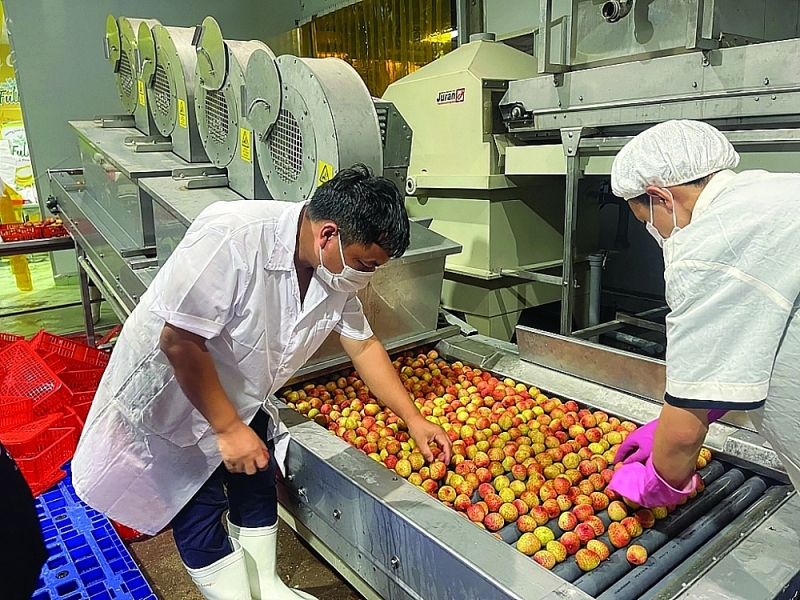Agricultures, Foods, News & Event
Struggle to achieve the target for fruit and vegetable exports
VCN – Due to certain difficulties in exporting to the Chinese market, this year’s fruit and vegetable export are expected to reach only about US$3.2 billion, significantly lower than the target of about US$3.8-4 billion set out from the beginning of the year. In order to increase added value, Vietnam’s fruit and vegetable industry need to focus on deepening processing as well as diversifying markets.

Durian is about to get over dragon fruit
According to the General Department of Customs, in September 2022, the export value of vegetables and fruits reached US$250 million, up 8.1% compared to September 2021. However, in the first nine months of 2022, the export value of vegetables and fruits was estimated at US$2.45 billion, down 11.1% over the same period in 2021.
A representative of the Import-Export Department (Ministry of Industry and Trade) said that in the structure of exported fruit and vegetable products in the first eight months of 2022, the leading fruit category in terms of export value reached US$1 .36 billion, down 21% over the same period in 2021. Notably, while the export of dragon fruit with the largest value decreased sharply, the export value of banana and durian increased sharply.
Processed products are the second largest category in the structure of exported fruits and vegetables. In the first eight months of 2022, the export value of this category reached US$660.9 million, up 11.1% over the same period in 2021. “Demand for processed fruits and vegetables has increased globally, but Vietnam has only met can meet a low proportion,” said a representative of the Import-Export Department.
From the perspective of the export market, Mr. Dang Phuc Nguyen, General Secretary of the Vietnam Fruit and Vegetable Association, assessed that in the first nine months of this year, the export of vegetables and fruits to many markets such as the US, Japan, and the EU all increased sharply. The market increased by 100%, however, exports to the Chinese market decreased sharply.
In-depth analysis of export products, according to Mr. Nguyen, currently, Vietnam’s leading main export fruit is dragon fruit with a turnover of over US$1 billion/year, followed by items such as mango, longan, pomelo, rambutan, mangosteen.
“Notably, durian will be a potential export product of Vietnam with expected turnover surpassing dragon fruit, reaching about US$2 billion/year”, said Mr. Nguyen.
He said: “China has officially licensed Vietnamese durians to be officially imported. Recently, Vietnamese enterprises have started exporting hundreds of tons of durians to China, welcomed by this country’s consumers. Each year, China spends up to US$4 billion on durian products, of which Thailand accounts for 90%, and the remaining 10% is divided between Vietnam and Malaysia. Exporting durian to China, Vietnam has the advantage of geographical location, and low transportation costs, which significantly increases competitiveness.”
Too much reliance on major markets
The implementation of new generation FTAs such as the Comprehensive and Progressive Agreement for Trans-Pacific Partnership (CPTPP), the Vietnam-EU FTA (EVFTA), etc., has been recognized by Mr. Nguyen as having helped the products.
Vietnamese vegetables and fruits increase competition and expand export markets. However, this year due to significant difficulties in the Chinese market when the country still maintains the “Zero Covid” policy, it is forecast that fruit and vegetable exports for the whole year will only reach about US$3.2 billion, down 10% compared to 2021. This figure is quite modest compared to the export target of US$3.8-4 billion set at the beginning of the year.
According to Mr. Do Quoc Hung, Deputy Director of the Asia-Africa Market Department (Ministry of Industry and Trade), although it is one of the 13 key agricultural products of Vietnam, Vietnam’s fruit and vegetable exports only account for about 1.4% of the world’s total fruit and vegetable imports. Many markets have not been fully exploited by Vietnamese enterprises. For example, in Japan, the country must import US$20 billion of vegetables and fruits each year. Vietnamese vegetables and fruits exported to Japan account for only about 3% of total imports, which is too low a figure, so it is necessary to promote exploitation.
Notably, even in the Chinese market, Mr. Hung analyzed, although Vietnam exports a large number of vegetables to this market, the number is still quite modest compared to the potential. The competitiveness of Vietnamese goods in China is not high. Each year, China needs to import about US$1 billion of bananas, of which the Philippines currently accounts for 50% of the market share, Cambodia accounts for 20%, and Vietnam only accounts for 16%. Regarding mangosteen, China imports US$800 million /year, and Thailand alone accounted for US$700 million.
“Vietnam’s dragon fruit products have an advantage in the Chinese market, but this country is also organizing dragon fruit cultivation with a sharp increase in area. Vietnamese enterprises need to be alert to grasp information to adjust suitably,” said Mr. Hung.
One of the limitations of fruit and vegetable exports pointed out by the leaders of the Asia-Africa Market Department is that the market has not been diversified, and it is too dependent on large markets; when the big market faced difficulties, it immediately affected Vietnam’s exports.
“In the context that exports are slowing down, it is very important to strengthen deep processing and diversify markets through specialized trade promotion activities for fruit and vegetable products. Enterprises need to do business methodically and improve their competitiveness to be able to export vegetables and fruits to difficult markets,” said Mr. Hung.
A representative of the Import-Export Department also said: “Vietnam’s fruit and vegetable industry needs to continue to shift strongly in product structure in the direction of increasing processed products, reducing exports of fresh products. Exporting enterprises need to step up investment in processing technology, post-harvest preservation and logistics development for transporting fruits and vegetables.”
